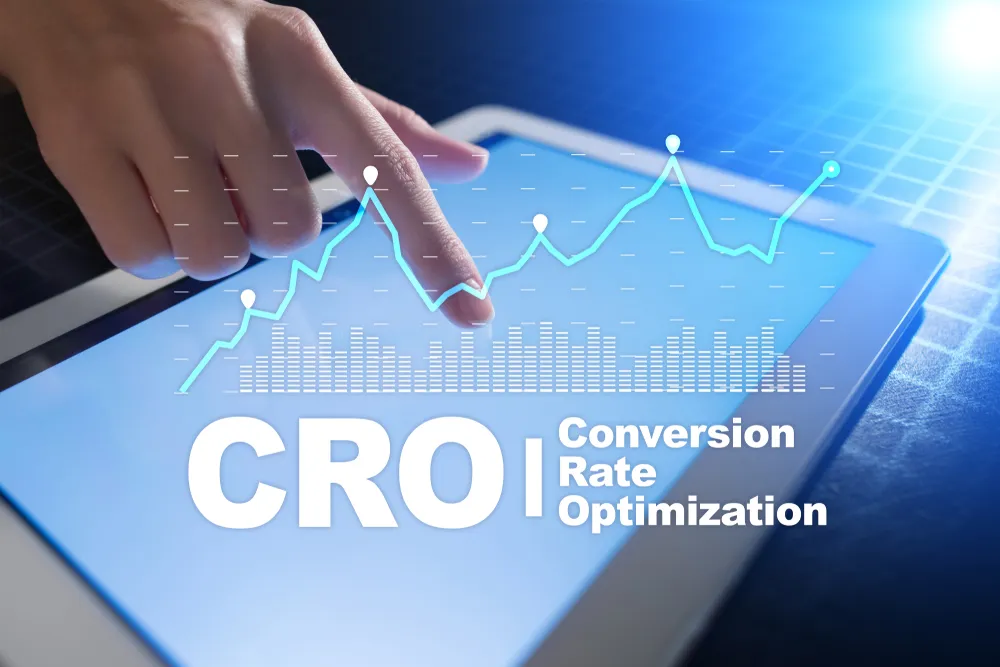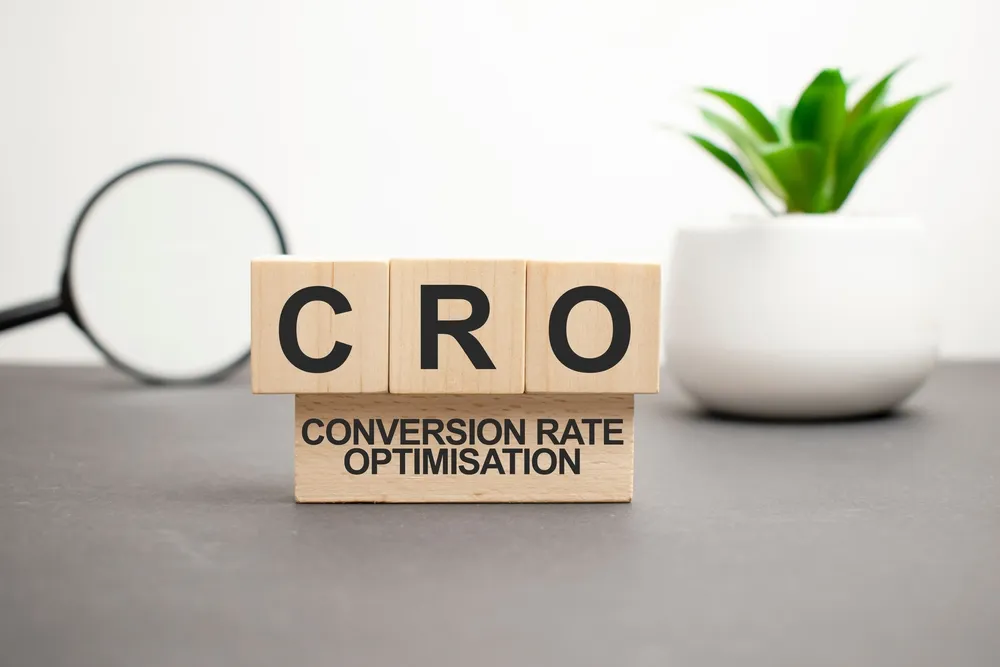In today’s world, digital marketing has revolutionized how a customer engages with a business. They don’t need to go to stores to make a purchase. Instead, with a few clicks and taps, they can simply add items to their virtual cart and complete the process. That’s why all businesses, big and small, invest in driving traffic to their website and opt for CRO best practices.
Conversion Rate Optimization (CRO) is a dynamic way for businesses to grow sustainably. CRO best practices encourages customers to stay on your website until they make a purchase. Therefore, optimizing your conversion rate is crucial for businesses to compel customers to take the desired action.
In this blog, we will cover what conversion rate optimization is, the five steps to optimize your conversion rates, dos and don’ts of optimizing your website.
What Is Conversion Rate Optimization?

Conversion rate optimization is the process of increasing the percentage of visitors to perform a certain action on your website. That can be signing up for an account, downloading an ebook, or making a purchase.
The importance of conversion rate optimization massively increased with the growth, viability, and availability of the internet in the 90s.
When the competition started to grow, marketing teams also experimented and worked on improving their web design and delivering better user experience. And in 2012, the introduction of Google Optimize became a vital part of digital marketing strategy and CRO best practices.
Why Is CRO Important?

CRO is crucially important for the success of your business as it helps you deliver exceptional customer experience. Here are the major benefits of CRO.
Boost In ROI
The increase in the percentage of visitors interacting with your website significantly increases the chances of boosting your business’ ROI. The higher the conversions, the higher the profit.
Increased Traffic
The increase in conversion rates leads to more potential customers discovering your website, understanding your value proposition and ultimately making a purchase.
Once satisfied with your product, they will surely spread the word with their inner circle. They will also leave their feedback and reviews, which will be your social proof. That means more and more potential customers will be likely to interact with your product.
Maximum Customer Value
CRO has the potential to improve all the major elements of your website massively. That includes the design, copy, or ads, ensuring that your potential customers stay on your website and make a purchase in the end. When you make changes to your websites based on your customer’s preferences, you will be more likely to achieve a higher conversion rate.
Moreover, CRO best practices improves new customer acquisition costs. Since you focus on delivering top-notch user experience, you will be getting more out of your existing visitors and customers.
How To Calculate The Conversion Rate?

The conversion rate is calculated by dividing the number of conversions by the number of visitors and multiplying that by 100 to get a percentage.
Calculating the conversion rate is easy; you only need to define a conversion. Then incorporate two values and multiply them by 100.
Suppose you’re defining a conversion from your ebook offer. In that case, you would divide the total number of ebook downloads by the number of web pages visited where the ebook is listed. Let’s say you had 400 downloads and 20,000 visitors last quarter; then, your conversion rate would be 2%.
You can also calculate the overall conversion rate of your website by dividing the total number of conversions by the total number of visitors.
What Are The Steps To Optimize Your Conversion Rates?

Since you are delving into the realm of CRO best strategies, it’s essential to understand how you want to start and manage your CRO campaign. Here’s what you need to know and do in order to move your potential customers down the sales funnel.
Understand Your Target Audience And Key Metrics
The very first step of optimizing conversion rates is to understand your audience and the key metrics you may want to utilize to convert them. The success of your conversions highly depends on how well you know your audience; you need to segment your audience based on their demographics such as age, income, gender, interests and location, etc.
Once you have created the ideal buyer persona, now it’s time to utilize the key metrics to help you optimize your conversion rates. Some of the valuable key metrics are the following:
- Subscription to a newsletter.
- Downloading an ebook or a brochure.
- The time spent on your webpage.
- Making a purchase.
- Upgrading a service plan
Collect Data
Once you better understand your target audience and key metrics, you need to collect more data to analyze user behavior. You need to discover how and from where your traffic is being driven, identify how your visitors interact with your website, and which areas you need to optimize to increase the conversion rate. Use the collected data to make hypotheses and make well-informed business predictions.
Perform Tests
After gathering data and setting hypotheses, the next step’s to perform different types of tests. In addition to testing tools, you should also conduct A/B Testing and multivariate testing (MVT).
A/B testing, or split testing, is an experiment where marketers show visitors two different versions of the same web page at random times. There are only one or two changes on those pages that can be in the form of font, CTA button, color scheme, or a combination of all.
While Multivariate Testing (MVT) is an experiment of making changes and modifications on multiple webpage elements. They are further tested to determine which combination of drives the most fruitful outcomes. With such a multitude of complexity in this experiment, that’s why they are mostly implemented on higher volume businesses.
No matter their approach, the end goal of both these tests is to identify which elements increase or decrease conversions.
As you conduct these experiments, ensure that you track your conversions appropriately and focus on the opportunities to optimize your website. To avoid confusion, you should also ensure that your content resonates with your target audience.
Make An Analysis
You need to utilize the data you collected in the second step for analysis. There are a few questions you will get the answers to, such as was your hypothesis right? Did the test succeed? Can you prove it with numbers and facts if you saw a boost in conversions? The best course of action while making an analysis is to keep in mind your initial goals and key metrics.
When you face failure in your analysis, never mind. Identify the opportunities for improvement, and move on to the next step.
Fine-Tune And Repeat
In this final step, you have to regather new data and analyze it again, reconsider your key metrics and reset your goals, fine-tune your marketing and ad campaigns, and repeat the entire process.
Since CRO is an ongoing process, you need to keep on fine-tuning your strategy. With continuous iteration, you will be able to achieve your desired results.
CRO Best Practices: Dos And Don’ts

When you are developing your very first CRO strategy, you will get inspiration from a wide array of sources. However, you will also be making a lot of mistakes and then some. Fret not; we have devised dos and don’ts to help you with your CRO journey.
Dos
Use High-Tech
Invest in high-tech tools and software to help you devise a CRO strategy and optimize your conversion rates. It’s essential to utilize advanced technology to keep yourself updated with the latest trends and gain a competitive edge.
Track Your Results
You always need to track and monitor your results in order to have a better understanding of your marketing endeavors. You will be able to know what’s working and what’s not. You can utilize tools like Google Analytics to analyze data and have a better picture of your conversions.
Gather Data
It’s highly essential that you gather accurate data to work on; it’s your key to success. So, you need to have thorough know-how and in-depth information about your conversions. This way, you can reevaluate and revise your digital marketing strategy whenever needed.
Don’ts
Never Using Paid Traffic To Get Started
Did you know that there are 8.5 billion searches on Google every day? These numbers should be sufficient to invest in paid traffic on both search engines and social media to get a head start and gain a competitive advantage. You need to interact with your customers first to get the ball rolling.
Making Too Many Changes At A Time
There is a limit to making changes to your website. Conducting A/B testing is okay but also highly recommended. On the other hand, making too many changes drastically at the same time make it difficult to analyze which changes made an impact on your CRO best practices. Sometimes, it even backfires, and you start to lose customers instead of gaining one.
Ignoring Your Intuition
Since you’re an expert in your business, you would know your business better. It’s true that high-tech tools and software do help a lot in optimizing your conversions. However, digital marketing fluctuates all the time. So, when it comes to making decisions on a hypothesis, you need to listen to your inner voice and intuition.
Conclusion
Conversion rate optimization can be nerve-wracking if you’re just starting out. However, if you are able to gather and analyze your data accurately, you will be one step closer to achieving your desired results.
Remember to gain a competitive edge, you also need to think out of the box and come up with new ideas and strategies based on your findings. Then, you will be able to successfully increase conversions and drive revenue for your business.
Need help to increase revenue using CRO best practices?
VinnCorp has a team of the best CRO experts for hire that will make a dynamic impact on your conversion rates and help you skyrocket your sales and revenue.
Request a consultation with CRO specialists.



